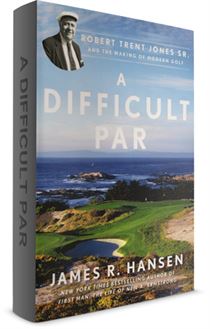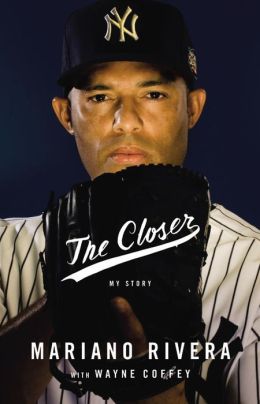The definitive account of modern golf's foremost architect from the "New
York Times "bestselling author of "First Man: The Life of Neil A.
Armstrong "
Robert Trent Jones was the most prolific and
influential golf course architect of the twentieth century and became
the archetypical modern golf course designer. Jones spread the gospel of
golf by designing courses in forty-two US states and twenty-eight
countries. Twenty U.S. Opens, America's national championship, have been
contested on Jones-designed courses.
"New York Times "bestselling
biographer James R. Hansen, author of "First Man: The Life of Neil A.
Armstrong," recounts how an English immigrant boy arrived in upstate New
York in 1912, just as golf was emerging as a popular pastime in
America. Jones excelled as a golfer, earning admission to Cornell
University, whose faculty consented to a curriculum tailored to teach
him the knowledge needed to design golf courses. Cornell provided the
springboard for an act of self-invention that propelled Jones from
obscurity to worldwide fame.
Jones believed that every hole should
be "a difficult par but an easy bogey." As gifted as he was at golf
design, Jones was equally skilled as a salesman, promoter, and
entrepreneur. "Golf Digest"'s annual rankings of the 100 Greatest Golf
Courses have regularly featured about fifty Jones designs, paving the
path for his two sons, Robert Jr., and Rees, whose work would carry on
their father's tradition. Hansen examines Jones's legacy in all its
complexity and influence, including the fraternal rivalry of Jones's
distinguished sons.
Check Catalog
Sports
You can click the links to check availability.
Tuesday, May 27, 2014
Monday, May 12, 2014
The Closer
The greatest relief pitcher of all time shares his extraordinary story of survival, love, and baseball.
Mariano Rivera, the man who intimidated thousands of batters merely by opening a bullpen door, began his incredible journey as the son of a poor Panamanian fisherman. When first scouted by the Yankees, he didn't even own his own glove. He thought he might make a good mechanic. When discovered, he had never flown in an airplane, had never heard of Babe Ruth, spoke no English, and couldn't imagine Tampa, the city where he was headed to begin a career that would become one of baseball's most iconic. What he did know: that he loved his family and his then girlfriend, Clara, that he could trust in the Lord to guide him, and that he could throw a baseball exactly where he wanted to, every time.
With astonishing candor, Rivera tells the story of the championships, the bosses (including The Boss), the rivalries, and the struggles of being a Latino baseball player in the United States and of maintaining Christian values in professional athletics. The thirteen-time All-Star discusses his drive to win; the secrets behind his legendary composure; the story of how he discovered his cut fastball; the untold, pitch-by-pitch account of the ninth inning of Game 7 in the 2001 World Series; and why the lowest moment of his career became one of his greatest blessings.
In "The Closer, "Rivera takes readers into the Yankee clubhouse, where his teammates are his brothers. But he also takes us on that jog from the bullpen to the mound, where the game -- or the season -- rests squarely on his shoulders. We come to understand the laserlike focus that is his hallmark, and how his faith and his family kept his feet firmly on the pitching rubber. Many of the tools he used so consistently and gracefully came from what was inside him for a very long time -- his deep passion for life; his enduring commitment to Clara, whom he met in kindergarten; and his innate sense for getting out of a jam.
When Rivera retired, the whole world watched -- and cheered. In "The Closer, "we come to an even greater appreciation of a legend built from the ground up.
Check Catalog
Mariano Rivera, the man who intimidated thousands of batters merely by opening a bullpen door, began his incredible journey as the son of a poor Panamanian fisherman. When first scouted by the Yankees, he didn't even own his own glove. He thought he might make a good mechanic. When discovered, he had never flown in an airplane, had never heard of Babe Ruth, spoke no English, and couldn't imagine Tampa, the city where he was headed to begin a career that would become one of baseball's most iconic. What he did know: that he loved his family and his then girlfriend, Clara, that he could trust in the Lord to guide him, and that he could throw a baseball exactly where he wanted to, every time.
With astonishing candor, Rivera tells the story of the championships, the bosses (including The Boss), the rivalries, and the struggles of being a Latino baseball player in the United States and of maintaining Christian values in professional athletics. The thirteen-time All-Star discusses his drive to win; the secrets behind his legendary composure; the story of how he discovered his cut fastball; the untold, pitch-by-pitch account of the ninth inning of Game 7 in the 2001 World Series; and why the lowest moment of his career became one of his greatest blessings.
In "The Closer, "Rivera takes readers into the Yankee clubhouse, where his teammates are his brothers. But he also takes us on that jog from the bullpen to the mound, where the game -- or the season -- rests squarely on his shoulders. We come to understand the laserlike focus that is his hallmark, and how his faith and his family kept his feet firmly on the pitching rubber. Many of the tools he used so consistently and gracefully came from what was inside him for a very long time -- his deep passion for life; his enduring commitment to Clara, whom he met in kindergarten; and his innate sense for getting out of a jam.
When Rivera retired, the whole world watched -- and cheered. In "The Closer, "we come to an even greater appreciation of a legend built from the ground up.
Check Catalog
Monday, May 5, 2014
Facing Mariano Rivera: Players Recall the Greatest Relief Pitcher Who Ever Lived
The all-time career leader in saves, with 652, Mariano Rivera is one of
the greatest professional athletes in history. Since taking over the
closer's role for the New York Yankees in 1997, until his retirement in
2013, Rivera saved 30 or more games in every season but one. In
addition, he has an astonishing MLB record 42 postseason saves, with 11
of them coming in the World Series. After 19 seasons in the Major
Leagues, his preeminence among relief pitchers is assumed and his
induction into Cooperstown assured.
And he accomplished it all, mostly, with one devastating pitch: his signature cut fastball. As third baseman Corey Koskie put it: "You knew what pitch [Rivera's] going to throw, a cutter. . . . You start to swing at the pitch and the next thing you know, the ball explodes your bat. I tried multiple things hoping to figure out a way get the barrel [of the bat] on one of his pitches. . . . Nothing worked."
Far from a conventional biography, "Facing Mariano Rivera" offers perspectives and testimonials from opponents and teammates alike, including Rivera's minor-league roommate and the final batter he faced in the major leagues. Some opponents had uncommon success against "The Sandman," and they share their secrets for hitting him. Most, however, echo the sentiments of five-time All-Star Mike Sweeney: "When you're at Yankee Stadium and Mariano Rivera is coming in the game, it feels like a horror movie . . . when you hear the music and you're scared to death, because you know what's going to happen."
Truly dominant pitchers come along only rarely. This book tells the reader what it's like to battle one of the all-time best, in the words of the players who did just that.
Check Catalog
And he accomplished it all, mostly, with one devastating pitch: his signature cut fastball. As third baseman Corey Koskie put it: "You knew what pitch [Rivera's] going to throw, a cutter. . . . You start to swing at the pitch and the next thing you know, the ball explodes your bat. I tried multiple things hoping to figure out a way get the barrel [of the bat] on one of his pitches. . . . Nothing worked."
Far from a conventional biography, "Facing Mariano Rivera" offers perspectives and testimonials from opponents and teammates alike, including Rivera's minor-league roommate and the final batter he faced in the major leagues. Some opponents had uncommon success against "The Sandman," and they share their secrets for hitting him. Most, however, echo the sentiments of five-time All-Star Mike Sweeney: "When you're at Yankee Stadium and Mariano Rivera is coming in the game, it feels like a horror movie . . . when you hear the music and you're scared to death, because you know what's going to happen."
Truly dominant pitchers come along only rarely. This book tells the reader what it's like to battle one of the all-time best, in the words of the players who did just that.
Check Catalog
Subscribe to:
Posts (Atom)



